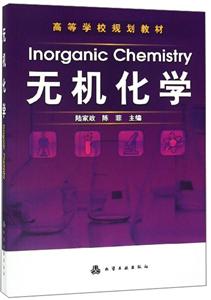-
>
宇宙、量子和人类心灵
-
>
气候文明史
-
>
南极100天
-
>
考研数学专题练1200题
-
>
希格斯:“上帝粒子”的发明与发现
-
>
神农架叠层石:10多亿年前远古海洋微生物建造的大堡礁
-
>
声音简史
无机化学 版权信息
- ISBN:9787122062505
- 条形码:9787122062505 ; 978-7-122-06250-5
- 装帧:一般胶版纸
- 册数:暂无
- 重量:暂无
- 所属分类:>>
无机化学 本书特色
本书针对药学类专业无机化学的双语课程,将无机化学课程的基本内容进行精选,结合国内高校教学实际,删除原版教材中大量的复杂、繁琐及较深奥的部分,力求使之既能体现无机化学课程的专业基础课特色,又可提高学生的英语应用能力。 鉴于医药学专业学生理论与实验课程并重的特点,全书包含两大部分:Ⅰ Inorganic Chemistry与Ⅱ Inorganic Chemical Experiments。Part Ⅰ includings thirteen chapters:1 Introduction,2 Structures of Atoms,3 Chemical bonds,4 Thermochemistry,5 Chemical Kinetics,6 Chemical Equilibrium,7 Solutions,8 Solubility Equilibrium,9 AcidBase Equilibria,10 An Introduction to Electrochemistry,11 Chemistry of Coordination Compounds,12 Nonmetals and Semimetals,13 Metals。Part Ⅱ includings three chapters:1 Basic Techniques of Experimental Chemistry,2 Typical Chemical Laboratory Apparatus,3 Experiments。 本书可作为高等院校本科药学及化学类相关专业的无机化学双语教材,也可作为化学专业英语课的教材或参考书。
无机化学 内容简介
《无机化学/高等学校规划教材》针对药学类专业无机化学的双语课程,将无机化学课程的基本内容进行精选,结合国内高校教学实际,删除原版教材中大量的复杂、繁琐及较深奥的部分,力求使之既能体现无机化学课程的专业基础课特色,又可提高学生的英语应用能力。鉴于医药学专业学生理论与实验课程并重的特点,《无机化学/高等学校规划教材》包含《无机化学/高等学校规划教材》可作为高等院校本科药学及化学类相关专业的无机化学双语教材,也可作为化学专业英语课的教材或参考书。
无机化学 目录
- >
烟与镜
烟与镜
¥18.3¥48.0 - >
唐代进士录
唐代进士录
¥16.1¥39.8 - >
李白与唐代文化
李白与唐代文化
¥9.9¥29.8 - >
推拿
推拿
¥12.2¥32.0 - >
有舍有得是人生
有舍有得是人生
¥25.7¥45.0 - >
姑妈的宝刀
姑妈的宝刀
¥15.7¥30.0 - >
企鹅口袋书系列·伟大的思想20:论自然选择(英汉双语)
企鹅口袋书系列·伟大的思想20:论自然选择(英汉双语)
¥6.3¥14.0 - >
伊索寓言-世界文学名著典藏-全译本
伊索寓言-世界文学名著典藏-全译本
¥6.7¥19.0
-
不良情绪应急处理包--孤独感
¥12.9¥30 -
不良情绪应急处理包--精神内耗
¥12.9¥30 -
孩子、家庭和外部世界
¥17.8¥56 -
北魏政治史(二)
¥26.2¥70 -
北魏政治史(四)
¥24.4¥65 -
北魏政治史(八)
¥20.8¥55
高速列车牵引电机微弱故障诊断与溯源研究
¥15.7¥49.0什么是数学(对思想和方法的基本研究)
¥38.8¥60.0化工园区安全风险评价理论及技术研究
¥14.4¥20.0地埋管地源热泵理论与应用
¥89.6¥128.0机器阅读理解:算法与实践
¥48.4¥79.0

















